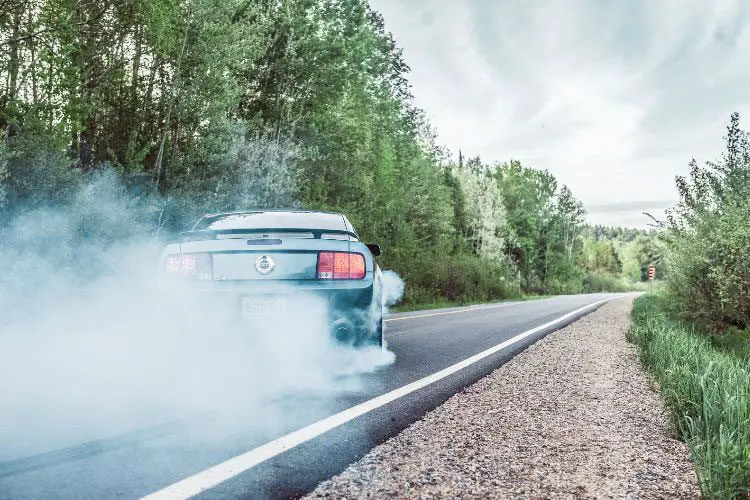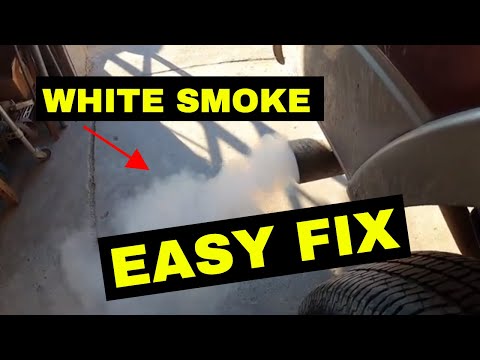Seeing white smoke coming from the exhaust is completely normal if you live in cold climate regions. But if that smoke doesn’t fade away after 30 seconds, you might be in trouble. You must troubleshoot the issues by finding the causes.
So, why is your car blowing white smoke but not overheating? If the smoke is coming from the exhaust, there can be problems with the cylinder head, engine block, or fuel injector. White smoke coming from the engine means leaking fuel or ECU error. Even the oil filler cap might produce white smoke.
In this guide, you will find out the exact reasons behind the issue. Also, we have enlisted the possible solutions so that you can make a decision on how to fix them quickly.
Reasons for White Smoke without Overheating the Car
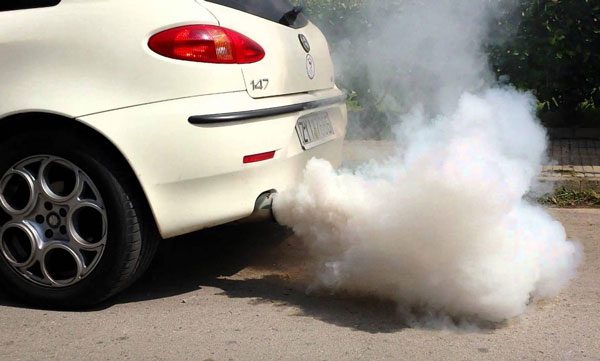
This chart shows exactly where to look for the problem and what could be the reason if your car blows white smoke without overheating. Check it out.
| The source of white smoke | Possible Reasons |
| Exhaust System | Head gasket or engine block is cracked |
| Engine oil or coolant is contaminated | |
| Using low-octane fuel | |
| Cracked or worn intake manifold gasket | |
| Faulty EVAP canister | |
| Bad fuel injectors | |
| Engine | Engine oil is leaking |
| The ECU is malfunctioning | |
| Coolant is leaking | |
| Exhaust system has water | |
| Oil Filler Cap | There is residue on the cap |
| Cylinders or piston rings are worn | |
| PCV valves are clogged |
Car is Blowing White Smoke But Not Overheating: Causes and Solutions

If you want to go beyond the above checklist to know the causes in detail and find the necessary solutions, here is a comprehensive discussion. Learn why your car is blowing white smoke without overheating.
1. Head Gasket Is Cracked
A minor crack in the head gasket of your car engine can cause the coolant, traveling through the narrow channels, to get into the combustion chamber.

Once the coolant reaches the combustion chamber, it starts burning with the fuel and produces white smoke with a slightly sweet smell. The smoke comes out from the exhaust system, and it might not be as thin as smoke caused by condensation.
In the beginning, the smoke might be light. But if you continue to ignore the problem, it can cause the cylinder head to get worse and blow more white smoke. In the end, the car might start overheating with a completely blown-out head gasket.
If this happens with your car, you might see other symptoms like rough idling or coolant levels decreasing more than usual.
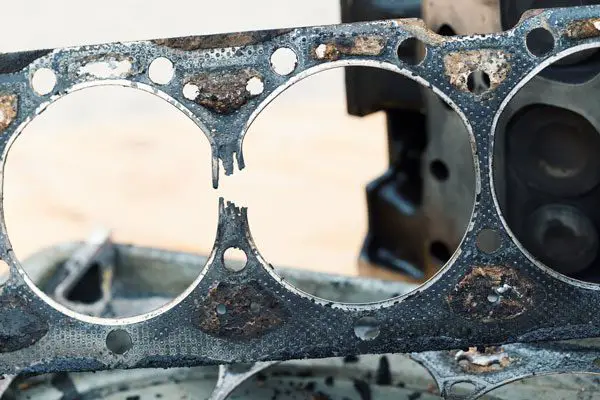
Solution
When the head gasket is diagnosed with one or multiple cracks, replacing the head gasket is the only solution. But you must choose the mechanic carefully, because replacing the head gasket is a precision job. It should cost between $1500 and $2000, including the parts and the labor.
If the head gasket isn’t snugly fit to the engine block, there can be crevices underneath. This will result in recurring smoke from the exhaust system.
2. Engine Block Is Cracked
Sometimes, it isn’t the head gasket that causes white smoke in your car. Instead, the engine block might be cracked, and coolant can enter the combustion chamber in a similar fashion. This will result in burning coolants and white smoke coming out of the car exhaust.
Identifying a faulty engine block is more complicated than that of a head gasket. So, many people are seen to ignore the issue unless the car starts overheating.
Let us reassure you that this problem will continue to worsen until you replace the whole engine block. The problem sometimes gets the head gasket involved, so you should inspect the gasket as well.
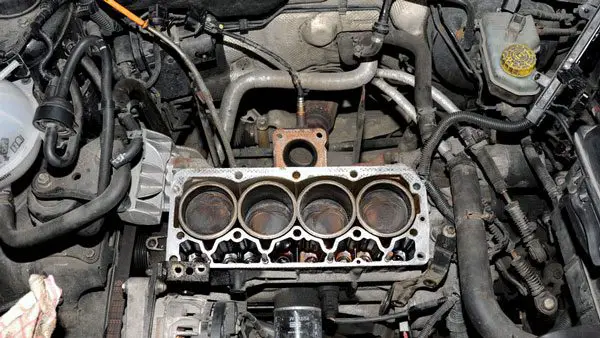
Solution
You must get the engine block replaced by an experienced mechanic. Remember, replacing engine blocks may be highly expensive. It can cost you up to $4000 to replace the engine block. And if you need to replace the head gasket too, the cost will rise higher.
3. Engine Oil or Coolant Is Contaminated
When you insert a dipstick to check the engine oil or coolant level, it should come out with no foam clinging to it. If you see foam while inspecting these fluids, chances are the fluids have been contaminated.
And when these fluids get contaminated, the car might blow white smoke out of the tailpipes without overheating. Some more facts to check are-
- If the fluids are clear but bubbly, the sump is probably overfilled
- The coolant is contaminated if the foam has a light brown color
- If the engine oil is dirty, there might be too much carbon deposit inside
- Sludging gives the oil a consistency similar to jelly
Fortunately, the frothy nature of these fluids can be easily identified by inspecting the condition of the engine oil or coolant.

Solution
To stop your car from blowing white smoke due to contaminated engine oil or coolant, you should go through regular oil changes suggested by the OEM.
The coolant reservoir should also be flushed from time to time. It will prevent unwanted substances from mixing with the coolant, hence blowing white smoke from the exhaust.
4. Using Low-Octane Fuel
You might have heard about octane numbers. It refers to the ratio of the iso-octane over the n-heptane in a fuel mixture. The higher the octane number, the better the engine will perform. This is because a high-octane fuel ensures the air-fuel mix isn’t ignited automatically during the compression cycle.
So, you must use the fuel with an octane number suggested by the OEM. If you use low-octane fuel in your car, it might not start blowing white smoke right away.
But using low-octane fuel for a long time will damage engine components, resulting in leaks. Pre-ignition can also happen due to low-octane fuel. All these will result in white smoke coming from the exhaust.
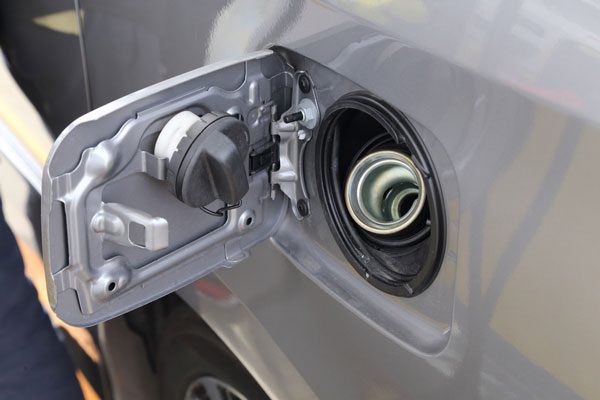
Solution
You should immediately stop using low-octane fuel in your car to solve the problem. After draining the fuel, you should flush the fuel tank thoroughly before refilling it with the right fuel grade.
This will ensure the car continues to perform efficiently for a long time.
5. Cracked or Worn Intake Manifold Gasket
Intake manifold gasket is used to seal the gap between the cylinder head and the intake manifold. This is usually made of rubber or plastic, so the gasket is highly susceptible to wear.
Excessive heat from the engine can also cause premature damage to the gasket.
When the gasket is worn or damaged, air or fuel will leak inside the engine. As a result, you will experience white smoke from the exhaust, but the car won’t overheat at this point.
The head gasket or engine block can sometimes develop cracks along with the manifold gasket. So, it is a bit difficult to figure out which is the main culprit.
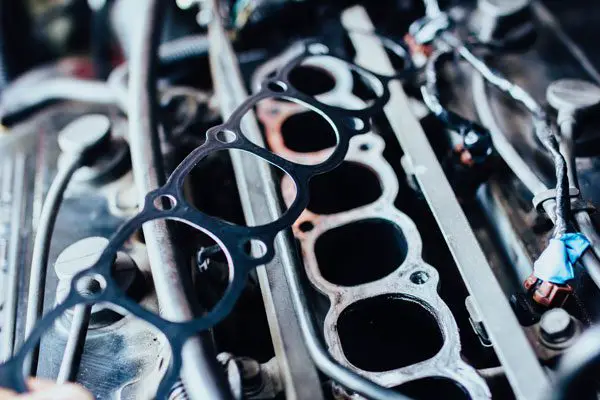
Solution
If the intake manifold gasket is cracked or worn, you should immediately replace the gasket. When replacing the gasket, ensure it has a tight seal to prevent air or fuel from leaking. It costs about $500-600 to replace the intake manifold gasket.
6. Faulty EVAP Canister
EVAP or Evaporative Emission Control System is responsible for arresting fuel vapors inside a canister filled with activated charcoal.
EVAP canisters are used in cars that stop fuel vapors from emitting, along with catalytic converters. Once the car starts running, this vapor is then drawn into the engine to burn with fuel.
When this module goes bad due to corrosion, clogged lines, or faulty sensors, the fuel vapor can’t be trapped inside the canister properly. This causes your car to blow white smoke without overheating.
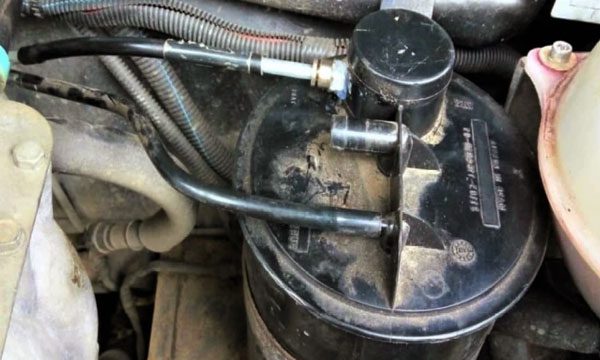
Solution
Testing the canister to determine its effectiveness is the first step. But if it is corroded or damaged, you must replace the whole module to stop white smoke from coming out of the exhaust. The cost of replacement is about $400-500.
7. Bad Fuel Injectors
Fuel injection systems ensures the right amount of fuel is pumped into the combustion chamber for the most efficient performance. But problems occur when the o-ring of the fuel injector is worn or damaged. The injector can also be stuck in an open position.
When either of these happens, more than necessary fuel is pumped into the combustion chamber. The engine can’t burn all the fuel inside the chamber.
And the excess fuel heads to the exhaust system to make white smoke come out of the exhaust. The smoke can sometimes be grayish, depending on the amount of unburnt fuel.
Here’s a video shows a bad fuel injector causing white smoke.
Solution
Replacing the o-ring might solve the problem. But if the problem is with the injector, you need to replace the whole thing. It can be tricky to figure out which one is bad, so you can replace both. It will cost about $250-350 to replace the setup.
8. Engine Oil Is Leaking
Sometimes, the exhaust may work fine, but the white smoke can be seen in the engine bay. It may be caused by an external engine oil leak that happens in the engine bay. If the engine oil gets in touch with the exhaust manifold, it will burn and create white smoke.
Engine oil getting inside the fuel line can also cause this kind of smoke.

Solution
Checking for engine oil leaks is the first thing you need to do. Also, check if any part of the exhaust manifold is wet or has burnt spots. Check valve cover gaskets and replace them if necessary. It will cost about $100.
9. The ECU Is Malfunctioning
Modern cars are equipped with ECUs or Engine Control Units that control almost all the internal functions of the vehicle.
But some sensors can go bad anytime, which will cause the computer to malfunction. The ECU itself can also go bad. So it won’t be able to send the right signal.
And the fuel injectors won’t be able to deliver fuel at the necessary rate. This irregularity will cause the engine to release white smoke without overheating. If the problem goes unchecked, the engine will start overheating gradually.

Solution
Resetting the ECU is the first step in solving this problem. You should get this done by an experienced mechanic. If the ECU is completely bad, you must replace it. It will cost you about $500-1000.
10. Coolant Is Leaking
Worn radiators, damaged caps, or faulty water pumps may cause the coolant to leak and drip onto hot engine components. As these components are too hot, they will create white smoke in the engine bay.
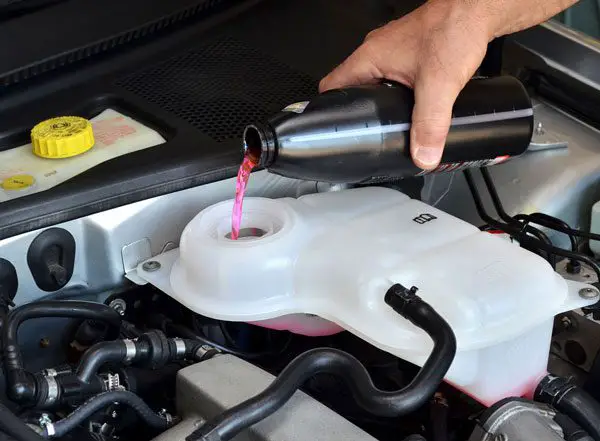
Solution
You must thoroughly check radiators, caps, or water pumps for leaks. Fix these leaks or replace the necessary parts to ensure no coolant is leaking in the engine bay.
11. Exhaust System Has Water
Water jackets are fitted throughout the vehicle to keep components cool. But if there is any leak in the cooling system or turbo, it will create white smoke surrounding the turbo and cooling system. The white smoke will escape the engine bay in the form of vapor or fumes.
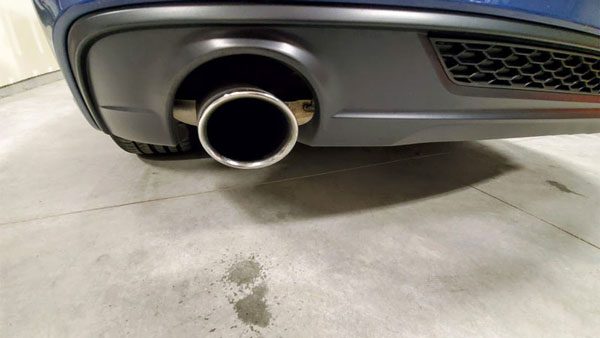
Solution
If the turbo is leaked or damaged, you must replace it to prevent water from going into the exhaust system. It can cost from $300 to $1200.
12. Residue on the Oil Filler Cap
When you fill the oil reservoir every time, the overfilled sump can cause some oil to stick to the filler cap. This causes deposits on the filler cap, which can burn when the engine is too hot. And when this residue burns, it releases white smoke.
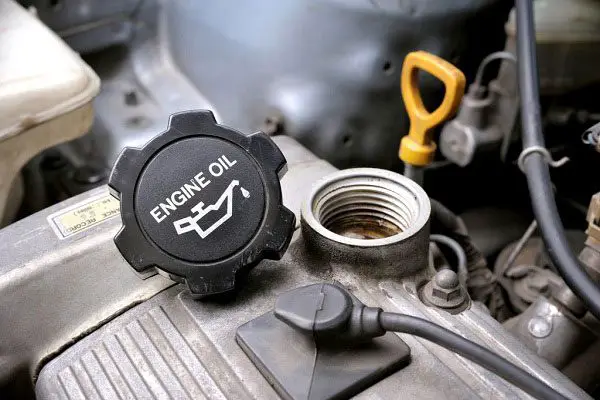
Solution
Cleaning the oil filler cap at regular intervals is essential to prevent white smoke. Also, ensure the fuel isn’t contaminated to slower the deposit rate.
13. Cylinders or Piston Rings Are Worn
Piston rings ensure there is no gap between the pistons and the cylinders. When this seal breaks off, oil can enter cylinders through the cracks.
Either of these components can be worn or damaged. After the oil is burnt, the smoke comes out of the rings instead of going into the exhaust system.
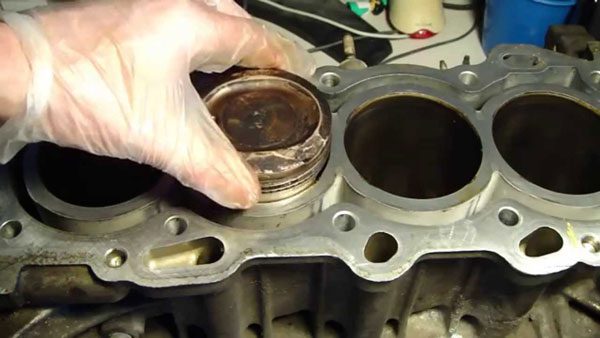
Solution
You should check the cylinders and piston rings for any sign of wear or damage. If these parts are faulty, immediately replace the parts to solve the problem. Replacing piston rings might cost up to $150 and cylinders might cost up to $3500.
14. PCV Valves Are Clogged
PCV valves or Positive Crankcase Ventilation valves are used to route the waste gases and unburnt fuel to the intake manifold. This way, the gases are burnt again to improve the vehicle’s fuel economy.
But the gases can’t reach the intake manifold if the valve is bad or clogged. Instead, they escape the engine block through the oil filler cap.

Solution
If the valve is clogged, try cleaning the valve. But you might need to replace the valve if it goes bad. It might cost up to $100.
If your car is blowing white smoke but not overheating, you may be interested in our articles on burning smell from car but not overheating and car overheats at high speed. These articles provide valuable information and solutions to common car problems related to overheating, such as coolant leaks, engine oil leaks, and other cooling system issues. Whether you’re experiencing a burning smell from your car but it’s not overheating or your car is overheating at high speed, our team at Car Problem Solved can help you diagnose and fix the problem.
FAQs
These are some of the most commonly asked questions about white smoke coming from cars. Check the answers below.
White smoke means something isn’t right in your car. You must not drive the car and take it to the mechanic to figure out the problem.
The oil level has nothing to do with the problem. But if the oil system leaks or the oil goes into the combustion chamber, the oil level will decrease drastically.
Yes. If the fuel filter is dirty, contaminants might mix with the fuel. As a result, white or grayish-white smoke will come out of the exhaust.
Conclusion
White smoke coming from the car indicates something is going wrong. You should identify the problem and mitigate the causes as soon as possible. To help you diagnose problems, we compiled multiple causes.
And then, we provided the necessary solutions to stop your car from blowing white smoke. This checklist will help you determine the root of problems and solve the issues efficiently.
